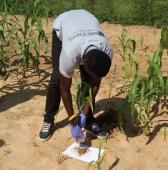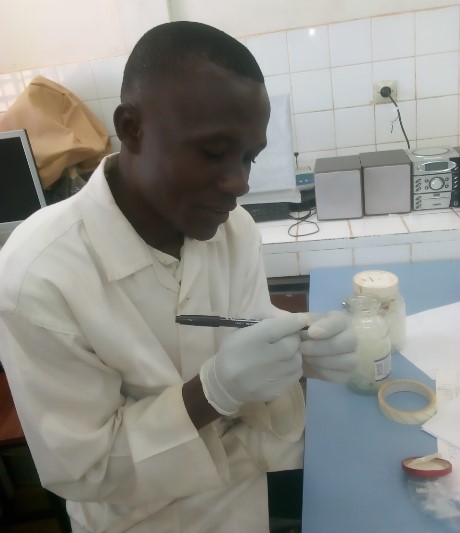Message from a Master’s student in Burkina Faso
Message from a Master’s student in Burkina Faso
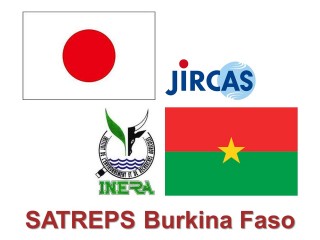 Contribution to SATREPS project
Contribution to SATREPS project
 Adama SAGNON
Adama SAGNON
(Master II student, Univertsité Joseph KI-ZERBO, Ouagadougou, Burkina Faso)
Introduction
Student at Joseph KI-ZERBO University, my name is SAGNON Adama. I just defended my Master in Biochemistry-Microbiology, option: Cellular and Microbial Biotechnology, in December 2020, using data collected from the SATREPS Burkina project. I got to know about the SATREPS project in June 2019 when Dr. Papa Saliou SARR (JIRCAS) came to Joseph KI-ZERBO University (Ouagadougou) to give a seminar on his researches. At the end of the workshop, Dr. SARR said he was searching for Master student to join the activity 3-3 of the SATREPS project, to closely monitor field and laboratory works in Burkina Faso. He also wanted to contribute to the capacity building of students in Burkina Faso through the project. I was then introduced to Dr. SARR by Dr. BONKOUNGOU J. O. Isidore of Joseph KI-ZERBO University. After discussion, I started the training in mid-July 2019 on the theme «Effect of Burkina Phosphate Rock-Enhanced compost on soil physicochemical and biological properties and sorghum productivity». The training was done at the Environmental and Agronomic Research and Training Center of Kamboinse (CREAF/K), under the co-supervision of Dr. TIBIRI Ezechiel and Dr. TIENDREBEOGO Fidèle.
Overview of the research
In Burkina Faso, sorghum is the main cereal crop. It is consumed by a large proportion of the population, is an animal feed, and is used in many domestic works. However, similar to that of other crops, its production is more and more limited by the low soil fertility, especially the scarcity of available phosphorus. This study was carried out to mainly test the effect of two phospho-compost types previously established in the SATREPS project on sorghum productivity. Apart from Burkina Phosphate Rock (BPR) addition, one of these composts also recieved rhizosphere soil as a microbial source during the composting. Other organo-mineral treatments were included (NP, sorghum straw, BPR, NPK). The study confirmed the good agronomic potential of the phospho-compost supplemented with rhizosphere soil, which gives sorghum yields comparable to that obtained by NPK. We also noted a higher abundance of phosphate-solubilizing microbial genes in the phospho-compost amended with the soil. The higher presence of such P-solubilizing microbes in soil would lead to a good P solubilization and P assimilation, justifying the good sorghum yields obtained with phospho-compost after amending with the soil.
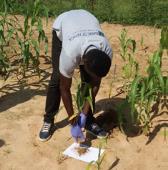
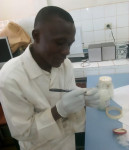
Personnal gains
Thanks to this research, I could do my first steps in the scientific research world and contact high-level researchers from JIRCAS (Japan) and INERA (Burkina Faso). Through the training, I learned laboratory techniques, several agronomic procedures in field trials, and the notion of soil fertility and the importance of soil microorganisms in agriculture. I also learned molecular biology analysis, soil nutrients determination, statistical and bioinformatic analytical software (R, XLSAT, and MEGAX), and LINUX system. I personnally thanks SATREPS for giving me this opportunity.
Difficulties encountered during the research
During field visits to Saria, we often faced some problems with transportation. As a consequence, some planned visits have been postponed. Because I did not have many statistics and bioinformatic analysis experiences, it was hard for me to select the adequate tools and methods to analyze my data. Furthermore, it is preferable to have a computer store the data adequately and perform more efficiently all data generated from the project’s activities.
Future perspectives
I wish to pursue the research on the formulation of phosphate rock-improved composts for sustainable agriculture in sub-Saharan Africa while further understanding the mechanisms leading to phosphate availability for plants. For that, we suggest to:
- Study other improved compost types using phosphate rock and various organic residues to have a more diversified range of composts of good quality, easy-to-adopt by local farmers
- Study the residual effect of phosphate rock-improved composts amendment on the soil physicochemical and biological properties and the productivity of leguminous crops such as cowpea
- Understand better the different interactions between soil microbes and plant growth. We plan to isolate and identify microorganisms with a high potential of phosphate solubilization to produce bio-inoculum. At the same time, we will further elucidate how these microorganisms solubilize and mineralize phosphate.
